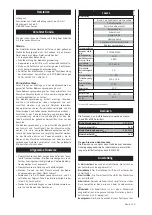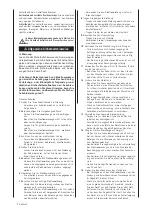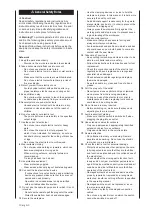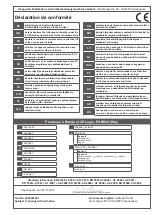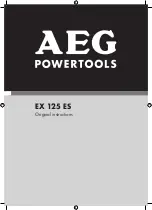
12 english
tension.
Note:
The tension lever is spring loaded so use extreme
caution when pushing the tension lever back into place to
avoid personal injury.
Mounting the worktable for use with the disc sander, Fig. 6
To use the worktable with the disc sander:
• Insert the index pin into the hole as shown in figure 6.
• Position the worktable not further than 1/16 in. (1.6
mm) from the sanding surface.
• Using a hex key, tighten the hex set screw securely.
Mounting the worktable for use with the belt sander, Fig. 7
To use the worktable for vertical sanding:
• Insert the index pin into the hole as shown in figure 7.
• Position the worktable not further than 1/16 in. (1.6
mm) from the sanding surface.
• Using a hex key, tighten the hex set screw securely.
CAUTION:
To avoid trapping the workpiece or your fingers
between the table and the sanding surface, the table edge
should
NEVER
be further from the sanding surface than
1/16 in (1.6 mm).
Assembling work support, Fig. 8.
• Place the work support over the holes in the side of the
tool housing.
• Using a hex key, fasten in place with the washers and
socket head screws.
Mounting belt/disc sander to work bench, Fig. 9
If your belt/disc sander is to be used in a permanent loca-
tion, it is recommended you secure it to a workbench or
other stable surface. When mounting the belt/disc sander
to a workbench, holes should be drilled through the sup-
porting surface of the workbench.
• Mark holes on workbench where belt/disc sander is to be
mounted using holes in the base as a template for hole
pattern.
• Drill holes through workbench.
• Place belt/disc sander on workbench aligning holes in
the base with holes drilled in the workbench.
• Insert bolts (not included) and tighten securely with lock
washers and hex nuts (not included).
Note: All bolts should be inserted from the top. Install the
lock washers and hex nuts from the underside of the work-
bench.
Clamping belt/disc sander to work bench, Fig. 10
If your belt/disc sander is to be used as a portable tool, it
is recommended you fasten it permanently to a mount-
ing board that can easily be clamped to a workbench or
other stable surface. The mounting board should be of
sufficient size to avoid tipping while belt/disc sander is
in use. Any good grade plywood or chipboard with a 3/4
in. (19 mm) thickness is recommended.
• Mark holes on board where belt/disc sander is to be
mounted using holes in the base as a template for hole
pattern.
• Follow last three steps in section Mounting Belt/Disc
Sander to Workbench.
If lag bolts are used, make sure they are long enough to
go through holes in belt/disc sander base and material the
belt/ disc sander is being mounted to. If machine bolts are
used, make sure bolts are long enough to go through holes
in belt/disc sander, the material being mounted to, and the
lock washers and hex nuts.
Adjustments
WARNING:
Before performing any adjustment, make sure
the belt/disc sander is unplugged from the power supply
and the switch is in the OFF position. Failure to heed this
warning could result in serious personal injury.
Adjusting the belt tracking, Fig. 11
• Plug in belt/disc sander.
To check belt tracking:
• Turn the switch ON and then immediately turn it OFF. If
the belt tends to slide off the idler drum or drive drum,
the belt is not tracking properly.
To adjust belt tracking:
• If the sanding belt moves toward the disc, turn the track-
ing knob clockwise 1/4 turn.
• If the sanding belt moves away from the disc, turn the
tracking knob counterclockwise 1/4 turn.
• Turn the switch ON and then immediately OFF again,
noting belt movement. Readjust tracking knob if neces-
sary.
Squaring the worktable to the sanding disc, Fig. 12
• Unplug the belt/disc sander.
• Using a combination square, check the angle of the
worktable with the sanding belt.
• If the worktable is not 90° with the disc, loosen the table
lock knob and tilt the table.
• Adjust worktable square to the sanding disc and retight-
en the table lock knob.
Note: Use the adjustment screw beneath the worktable to
move the table further or closer to the sanding disc.
WARNING:
Before attempting to use your belt/disc sander
familiarize yourself with all operating features and safety
requirements.
Locking the switch, Fig. 13
• Place the switch in the OFF position.
• Wait until the belt/disc sander has come to a full and
complete stop.
WARNING:
Do not reach across the sanding disc to turn the
belt/disc sander ON or OFF. Contact with the sanding disc
can result in serious personal injury. See Figure 13.
m
Hints for work
Bevel sanding, Fig. 14
The worktable can be tilted from 0° to 45° for bevel sand-
ing. To tilt the worktable:
• Loosen the table lock knob by turning it counterclock-
wise.
• Set worktable to desired angle.
Note:
Position the worktable not further than 1/16 in. (1.6
mm) from the sanding surface.
• Tighten the table lock knob by turning it clockwise.
Sanding small end surfaces using the miter gauge, Fig. 15
A miter gauge is included with your tool for increased ac-
curacy. Use of a miter gauge is recommended for sanding
small end surfaces on the sanding disc.
Note: Always move the workpiece across the sanding disc
from the left side towards the right side.
Horizontal and vertical sanding, Fig. 16
Your belt/disc sander can sand both vertically and hori-
zontally. Depending on the workpiece, the work support
can be used with either the horizontal or vertical sanding






